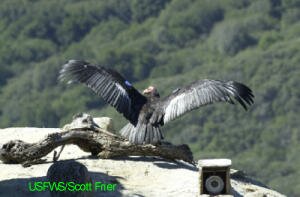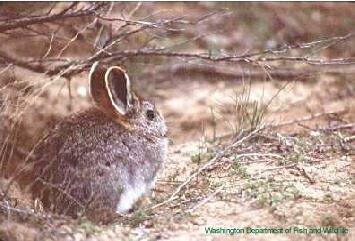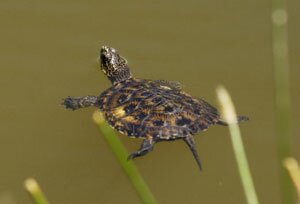
Oregon Zoo
Field Conservation Partnerships
Rearing Pacific Northwest Species
A major component of the Oregon Zoo's field conservation program involves projects to enhance the survival of wildlife species in our own backyard. These projects directly involve Oregon Zoo staff, students, interns and volunteers and make use of Zoo facilities.
We continue to expand the number and location of our field conservation projects as new opportunities are identified.
 California Condor (Gymnogyps californianus) California Condor (Gymnogyps californianus)
Lewis and Clark saw their first California condor on October 30th, 1805, near the confluence of Wind River with the Columbia, just upstream of the current town of Cascade Locks. During their stay in Oregon, they obtained several specimens and made careful measurements of the largest bird in North America, which was common at the time. The last sighting of a California condor in Oregon was made in March of 1904 at Drain, Douglas Co., less than a century later. By the 1980s, the condor, numbering no more than 22 birds, had disappeared from all but a small part of southern California.
Today, thanks to a cooperative captive breeding and recovery program led by the U.S. Fish & Wildlife Service, in cooperation with the San Diego Wild Animal Park, the Los Angeles Zoo, and the World Center for Birds of Prey in Boise, Idaho, the condor population has rebounded to 198 birds, 80 of which are flying free over the central California coast and the Vermilion Cliffs of Arizona.
Will the California condor ever return to Oregon skies? It's too soon to speculate whether or not that's a possibility. However, condors will be returning to Oregon as a part of the captive breeding program.
Oregon Zoo joined the California Condor Recovery Program on September 26, 2001. We are planning to build our facility off zoo grounds at a remote site in Clackamas County. Zoological Curator Jan Steele has been appointed as the Zoo's representative on the California Condor Recovery Team and is coordinating development of the Zoo's captive breeding facility with the team. The Zoo anticipates receiving its first Californa condors in breeding pens scheduled to be completed in the fall of 2003.
The ultimate goal is to house 16 breeding pairs of California condors. Offspring from our condors will become part of the reintroduced flocks flying free above the southern California coast and the north rim of the Grand Canyon. The Oregon Zoo Foundation has launched The Campaign for Condors to fund the breeding and rearing facility, followed by an on-grounds exhibit to educate zoogoers about the fall and rise of the California condor.
 Columbia Basin Columbia Basin
Pygmy Rabbit (Brachylagus idahoensis)
The isolated Columbia Basin pygmy rabbit received permanent listing as a federal endangered species on February 20, 2003. At this time, fewer than 30 individuals of this distinct population segment are thought to survive in the wild.
Since 2000, Oregon Zoo has been working with Washington Department of Fish and Wildlife (WDFW) to develop husbandry techniques to successfully breed pygmy rabbits in captifity for eventual reintroduction. Our breeding facility could reach capacity (24) by July 2003. WDFW is coordinating genetic and population management of captive pygmy rabbits.
The Zoo will also grow 1,500 sagebrush seedlings per month to feed 5 seedlings per day per rabbit to supplement other food. Before reintroduction (earliest date could occur in 2004), the rabbits will gradually be switched to a natural spring-summer diet of sagebursh, grass and broadleaf forbs (herbaceous plants other than grasses).
Kincaid's Lupine (Lupinus sulphureus ssp. kincaidii)
A threatened plant, Kincaid's lupine is the host plant for the endangered Fender's blue butterfly (Icaricia icarioides fenderi). Both have suffered from nearly complete loss of their native dry grassland habitat in the Willamette Valley. The Zoo has begun a project to cultivate Kincaid's lupine both as a future food source for the endangered Fender's blue butterfly larvae and for restoration of lupine habitat.
 Oregon Silverspot Butterfly (Speyeria zerene hyppolyta) Oregon Silverspot Butterfly (Speyeria zerene hyppolyta)
The surveyed population of the threatened Oregon silverspot butterfly declined from over 1,000 in 1992 to 57 in 1998 at Cascade Head Reserve. Oregon Zoo, The Nature Conservancy and Seattle's Woodland Park Zoo have joined in a conservation partnership to supplement the butterfly population while habitat is being restored. In 2000, 190 pupae and larvae were released into the area. In 2002, female butterflies laid over 4,000 eggs by the end of October. Based on past survivorship data, both Oregon Zoo and Woodland Park Zoo could each produce over 500 pupae to supplement the Cascade Head population or reestablish other historic populations over the coming years.
The western blue violet (Viola adunca) is a relatively common native vilet growing on headlands and in meadows along the Oregon coast. It is the larval food plant for the Oregon silverspot butterfly. Although larvae of this species have been raised on other violets, it is the consensus of the recovery team that only Viola adunca be fed to larvae raised for population supplementation. The Washington Department of Fish and Wildlife has provided the Zoo with western blue violet stock. The Zoo hopes to have 1,500 potted plants to feed silverspot larvae.
Western Pond Turtle (Clemmys marmorata)
 Western pond turtles have nearly disappeared from Washington, largely due to predation by nonnative bullfrogs. We are helping to expand Woodland Park Zoo's "head-start" program by rearing these turtles in our Africa Swamp kitchen. When they are too large to be eaten by bullfrogs when returned to the wild. Since 1998, the Oregon Zoo has returned over 100 western pond turtles to the wild. Additional information on the Western pond turtle can be found at the Washington Fish & Wildlife website. Western pond turtles have nearly disappeared from Washington, largely due to predation by nonnative bullfrogs. We are helping to expand Woodland Park Zoo's "head-start" program by rearing these turtles in our Africa Swamp kitchen. When they are too large to be eaten by bullfrogs when returned to the wild. Since 1998, the Oregon Zoo has returned over 100 western pond turtles to the wild. Additional information on the Western pond turtle can be found at the Washington Fish & Wildlife website.
Click here to make a tax-deductible donation to Future for Wildlife
back to top
|



